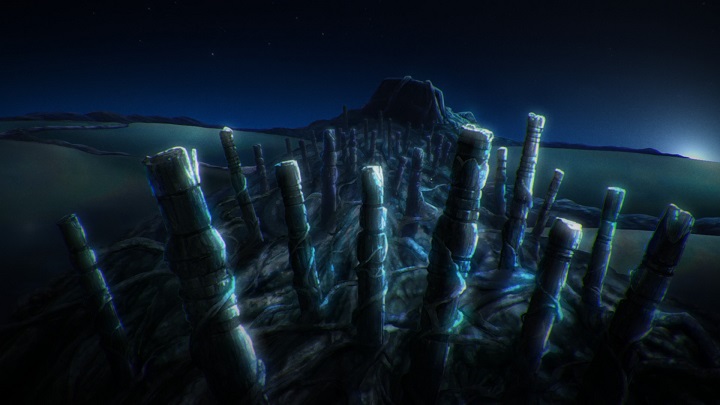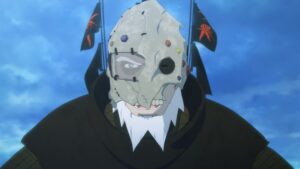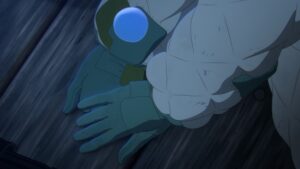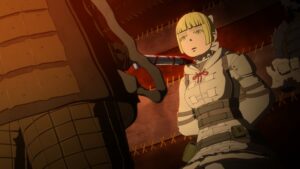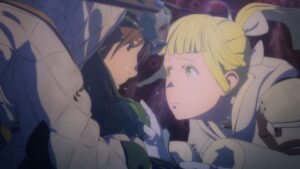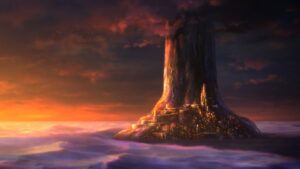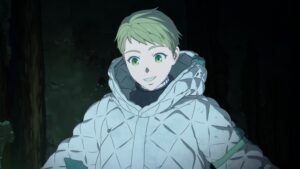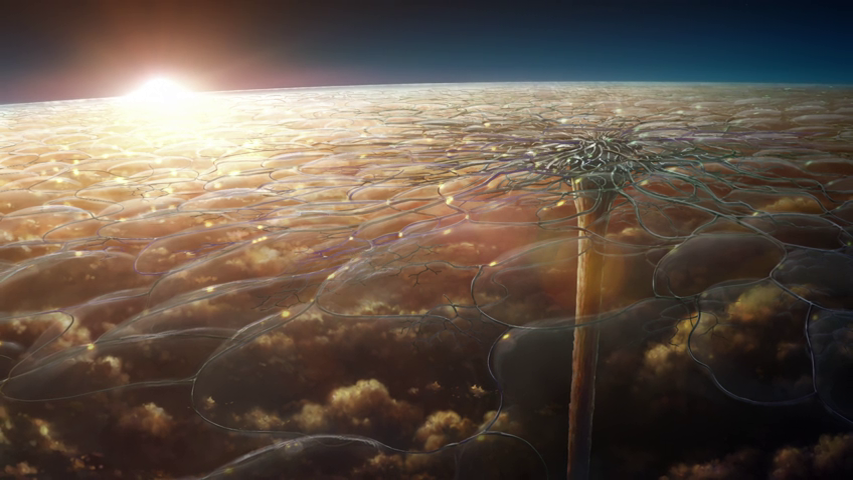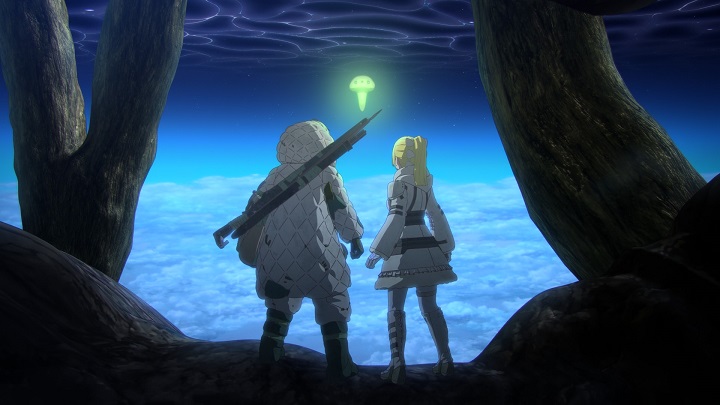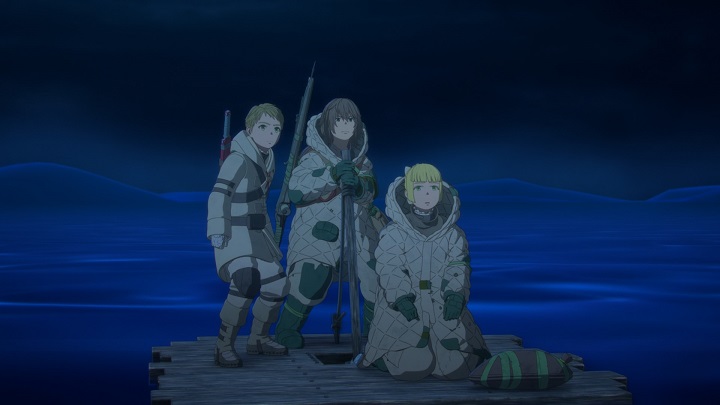CGI has had a bad rep in anime fandoms for a long time, and it isn’t undeserved. From Berserk (2016) to that bear in Golden Kamuy, studios typically aren’t very good at it. And why should they be? It’s generally a cost-saving measure. There are only two studio’s that really seems to care and invest in their CGI pipeline. The first is Studio Orange, the team responsible for Houseki no Kuni and the latest Trigun Stampede, the front-runners in the industry. The second, and the ones responsible for the topic of this review, is Polygon Pictures. And while not quite at the same level as Orange, it’s clear from this latest project that they are really trying. So without further ado I give to you, directed by Hiroaki Andou, created by Tsutomu Nihei with music by Kouta Yamamoto, Misaki Umase and Hiroyuki Sawano, Polygon Picture’s latest attempt: Kaina and the Great Snow Sea.
Be warned, this review contains minor unmarked spoilers for Kaina and the Great Snow Sea. It also contains major spoilers in some sections however these will be heavily marked to avoid accidents.
Production
Diving in head first, there’s one thing that immediately comes to mind when thinking about Kaina’s production: Backgrounds. They are absolutely stunning. Huge props to Yoshikatsu Matsumoto, the 3DBG Matte Painting Supervisor, and Kimiko Kubo, the Art Director, as well as their team. Every episode these were consistently the most beautiful shots of the show. Not only were they highly detailed, beautifully lit pieces of art, they brought Kaina’s fantastical world to life in a way I couldn’t have imagined from the PV. How do you really conceptualize giant trees reaching into the atmosphere, connected by a translucent web-like canopy, the sun’s rays shining off its surface as these branches/tendrils stretch on for miles? Or a city built up and around the trees base, woven into the very roots themselves? You can’t! Not with the same detail and creativity of these backgrounds at least.
But don’t think for a moment these backgrounds are only used in wide, empty shots! Oh no, they are integral to every facet of Kaina’s world. Do you remember the “3D” part of Yoshikatsu Matsumoto’s title? Well it’s very important. Because his work is specifically created to be applied to 3D models. Models like say… a giant tree. This ends up giving the roots and trunk, all the wood really, a beautiful texture that makes this otherwise giant 3D cylinder look authentic. Even as the characters climb around and walk all over it, it still works. The trees, the characters the boats, they all feel like they belong in the same world as they interact with each other. This leads to another of great shots as the characters are running along roots and such. Rather then floating on top of the background, they feel like part of each other.
Sadly, it’s that “running” bit where Kaina starts to falter. As beautiful as the backgrounds are, the fidelity of the CGI humans simply can’t keep up. Generally low detail, the characters are very “anime” in an otherwise highly detailed world. For anyone used to watching anime, this probably won’t be a big deal. You’re used to how anime faces are designed at this point. But for those newer I can see it throwing them off. In particularly, Kaina doesn’t do a very good job with shadows. Using a CGI shader, Kaina attempts to shade models based on their own geometry and light sources. Often this is fine, most characters are overall smooth so there’s no jagged edges. But with older or more complex characters, like the Canopy elders with their wrinkly faces, it’s very noticeable and generally rather ugly.
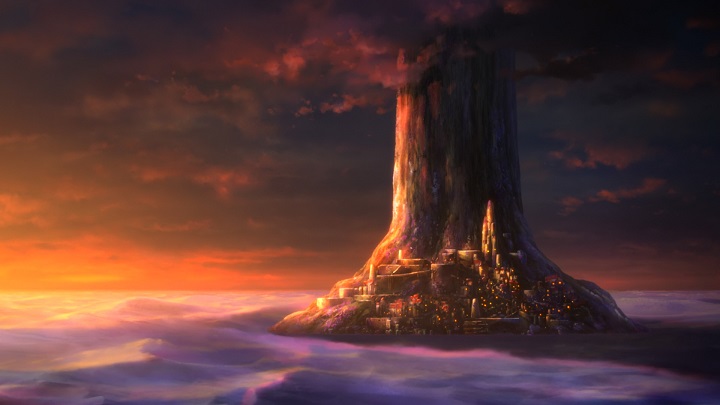
Additionally, for a show named Kaina and the Great Snow Sea, Polygon Pictures really can’t do snow. Like… at all. It’s giant beach-ball sized globs. From falling in the sky to being kicked up as the ships move through it, Kaina’s snow looks terrible. Now I get it, there are limitations to what Polygon Pictures can do, rendering that many snow flakes would probably kill them. But when contrasted against absolutely gorgeous snow-scapes like the one above, you can’t help but feel like you lost something. Luckily for Kaina, as questionable as it’s CGI can be at times, Polygon Pictures does do a decent job of actually animating it. The characters can generally move just fine. Occasionally they even move well, with some rather dynamic action scenes as they cross swords! While few and far between, when these do happen they are always a treat.
All in all, for a CGI production that I went into expecting absolutely nothing from, Kaina pleasantly surprised me. A step up from most CGI productions, barring those made by Orange anyway, Polygon Pictures is definitely starting to carve out their niche. Between this and Drifting Dragons I feel like they are finally starting to figure this “CGI” thing out. Hopefully they are able to take what they have developed here and, with a bit more time, money and practice, turn it into something truly special for the upcoming movie.
Narrative
As praise worthy as Kaina’s CGI is, compared to most anime CGI at least, it’s story leaves something to be desired. Unsurprisingly, Kaina’s setting is pretty good! The background art goes a long way towards establishing and fleshing it out, but Kaina’s narrative doesn’t just ignore that. Kaina living on top of giant trees? Yeah, he can see pretty far and saw some stuff those on the snow sea didn’t. Snow is falling from the sky in a world that never gets hot enough to consistently melt it? Well the snow sea level is rising and older parts of the city have become submerged, leading to some more gorgeous shots under the snow. People are running out of water? Yeah, someone is going to go on a war-path to steal everyone else’s water. Kaina’s world doesn’t just exist for no reason, it informs the story, as it should.
So why then is Kaina’s story lacking? Well I see 2 main reasons for that. The first is due to how Kaina was made. Simply put, it’s incomplete and to short. Kaina has a moving coming up in a few months, which might serve to alleviate some of that, true. But even then, Kaina is an 11 episode show set in a world that could easily be a full 2-cour, 24 episode season. That’s how well built up this setting and premise is. What Kaina starts is far grander then what its actually been given. So because of it’s short season and offloading of its true finale to a movie, your experience with Kaina as a show is probably going to feel lacking. It doesn’t end in a way that is satisfying as a stand-alone season.
As for the second? Well for this I will have to dive into spoiler territory, as it pertains to Kaina’s ending and the implications of it. If you don’t want to be spoiled then skip this section. If you don’t mind, or have already seen it, then read on.
So, what is Kaina’s other big narrative screwup? Simply put, in the last 2 episodes Kaina undermines everything the story is based on and speeds through any and all consequences of these decisions. The core conflict of Kaina’s entire world is centered around the scarcity of water, an important resource. And yet for some reason, Kaina never gives any reason or justification for why the people of this world can’t just… melt the snow. The snow that, in the penultimate episode, is melted by Deus Ex Machina and that everyone is surprised to find is actually water. Kaina’s entire conflict is built on ignorance of a basic scientific fact: Things melt! I don’t think it’s to much to ask for a small “The snow is infected/salty” throwaway line to explain it away.
As for the rush? Kaina spends a lot of its runtime building up to an answer for this scarcity problem. Of setting up this fabled location where water isn’t an issue, a place they can go to save their people. Yet not only is this fabled location completely undermined by the fact that snow can melt, but Kaina speed runs through convincing anyone of it in the span of 5 minutes. One of the main conflicts of the last 5 episodes, figuring out a way to convince those in charge that it isn’t a fairy tail, gets glossed over in the credits! Kaina does introduce a map, yes. But that map burns up in a fire, it’s a whole big narrative moment of choosing the map vs saving a person. Yet there’s no consequences for this, because they end up not needing it to begin with.
Thus I ask you: Why bother with the map at all?
Over all, Kaina’s story isn’t bad. In fact I think the early portions, as Ririha and Kaina meetup and travel together, are quite good! It’s well paced, the characters get plenty of time to interact and connect without it feeling like dead, wasted time. Both the heroes and villains have agency, Kaina himself gets one of the coolest moments of the entire show when he figures out a way to surprise the bad guys that no one has ever done before. It’s great! Kaina only falters in the last few episodes as it tries to tie things up in preparation for the movie. Had it 2 more episodes to properly end things, heck even just 1, I think Kaina’s ending would be a lot stronger. Instead it comes off very much as a “Go see the movie” ending, and those are never great.
Characters
Moving on, as questionable as the narrative’s ending might be, how do the characters themselves fair within said narrative? In the interest of being positive after that last section I’ll just come out and say it, they do well! Not perfect, Kaina has some issues here and there, but mostly only in regards to the previously mentioned finale. Prior to that, and even during for many, Kaina’s characters are likeable and intelligent. Kaina has this sort of country bumpkin personality to everything. Yet because of how fantastical and magical Kaina’s world is, so different from most standard fantasy, Kaina’s ignorance plays into the audiences own, allowing him to be an effective excuse for a lot of explanation. Yet none of those explanations feel “Info-dumpy”, as they are often given in a quick and to the point fashion.
The rest of the main cast, Ririha and Yaona, are similar. Both have solid motivations regarding their kingdom and develop their own relationships independent of each other. They aren’t reliant on being together to be characters, with every pair of this trio having their own bit of the story of just them getting to know each other and interacting. Really the only “Bad” characters in Kaina are the old men in charge, the Admiral and the King of Atland. Both come off as very one note, with the Admiral especially being your stereotypically crazy evil old man who wants to conquer for the sake of conquering. There’s no nuance to either of them. Considering how important the Admiral is to Kaina’s story, that’s a shame.
Luckily the Second in Commands, Orignoa and Amelothee, carry both sides of this conflict. Both get about as much screen time as their commanders, but that screen time is used far more effectively. Amelothee especially spends the entire season being built up as this effective, efficient, terrifying yet sympathetic villain. Her arc isn’t exactly surprising, it’s telegraphed from her initial introduction. But that doesn’t mean it’s done poorly. Simple and effective is better than complex and mediocre in my book. Of course it helps that, unlike the two leaders, Orinoga and Amelothee interact relatively often. So not only do they build each other up, their relationship becomes the true face, the true front line, of the greater conflict.
All in all, Kaina’s characters are perhaps the most effective part of Kaina’s story, aside from the backgrounds that is. Their personal struggles and narrative arcs as they traverse this world will carry you through most of Kaina’s run time. Will you be disappointed a bit at the end by the rushed finale and what it does to some of them? Yeah, probably. But at least the journey won’t be terrible.
OST
With that we come to the final, and most positive, section of this review: The OST! Kaina’s OST is in a fun place, with 3 separate composers involved. The first is a name you probably recognize, one that has created countless beloved OSTs, Hiroyuki Sawano. Alongside him is a long time collaborator, someone who has worked with Sawano over and over again for over half a decade, Kouta Yamamoto. And finally, making her debut appearance as a composer, Misaki Umase. Together these three crafted what I think is one of the best OSTs of the season. That said, most of the credit goes to Yamamoto and Umase, as Sawano was only involved for the creation of the main theme, an important but small section of the music.
Focusing in on those two, Yamamoto and Umase’s contributions feel like two completely separate approaches to music. This was only a collaboration in the sense that they each wrote half of the OST rather then creating each song together. And you feel that not only in the music itself, but in the very track names. Yamamoto is very reminiscent of that Sawano style. Sweeping, heroic epics like “K_save_G“, grand orchestras like “K_village_G” and looming ominous sounds that reverberate through your skull like “K_character_G“. And yes, those are their names, that to is a Sawano-ism. These sorts of large, overwhelming sounds are very typical of his music. Suffice to say, if you like Sawano, you’ll like Yamamoto’s work here on Kaina. Personally though I prefer, and am much more interested in, Umase’s style of music.
Umase’s sound is much softer, with a stronger focus on strings and single centerpiece instrument arrangements, such as in “Amelothée“. That isn’t to say she can’t do larger epics or action pieces, they are simply different. Take for instance “The duel of freeze“, which uses less reverb than Yamamoto to achieve a similar effect, even going so far as to use what I believe are Didgeridoos near the middle. Most telling of all though, Umase seems to have a love for mystical, ancient sounds like in “Hikari” and “Origin“. This also carries through into her vocal tracks, such as my personal favorite of the OST “In the snowsea“. As someone who has listened to Sawano/Yamamoto’s brand of music for a long time, I find Umase’s stuff very appealing. Luckily however, Kaina uses both very well, so there’s something there regardless of which you prefer.
However good either composer’s music is though, it would mean little if Kaina didn’t use the OST to its fullest. And this is where Kaina impresses me the most. Kaina’s integration of its music and visuals, how the two play off of each other and interact, the music informing what is happening on screen and vice versa, is fantastic. I’m not just talking about having a cool action track as our leads are getting chased. I mean timing orchestral swells with the reveal of a vista, or a new instrument with a character’s appearance on screen. Kaina’s music does not exist independently of the show, like so many other series. They work together, making it truly memorable and worth listening to.
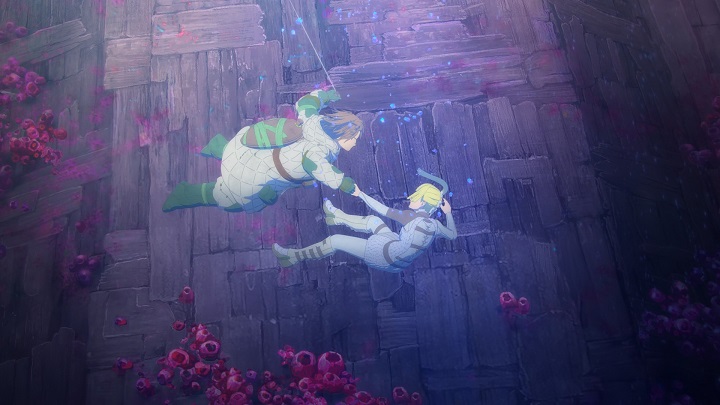
Conclusion
All in all Kaina is a strong fantastical adventure in an engaging fantasy world that stumbles a bit towards the end and delays its payoff to a movie a few months out. Did I enjoy my time watching Kaina? For the most part. It’s certainly my surprise of the season, as I didn’t expect it to be anywhere near as consistent as it was. Considering how low the expectations for it were, Kaina definitely made its mark on the season and was a worthwhile watch hitting above its weight. Just be prepared for it to not feel like a complete experience by the end, despite its status as an original that should be able to finish in a single season.
